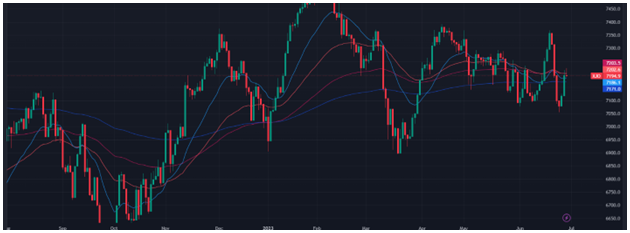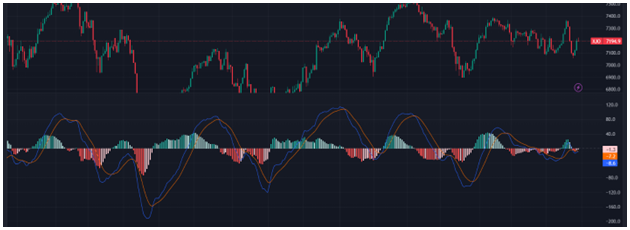What will you learn through this module?
In technical analysis, lagging indicators are commonly used to assess historical price movements and provide insights into potential future market trends. These indicators are called "lagging" because they trail behind the price action and are based on past data. This article will explore the introduction of lagging indicators in technical analysis and their significance for traders and investors.
Lagging indicators in technical analysis are designed to confirm the direction and strength of price movements after they have occurred. Unlike leading indicators, which aim to predict future price movements, lagging indicators provide a retrospective view of market behaviour. They help identify trends, determine entry and exit points, and validate the sustainability of price movements.
One of the most widely used lagging indicators is the moving average. It calculates the average price of an asset over a specified period and smooths out short-term fluctuations. Moving averages are often employed to identify the overall trend of a market, whether it is bullish (upward), bearish (downward), or ranging (sideways). Traders commonly use crossover strategies, where shorter-term moving averages crossing above or below longer-term moving averages can signal potential buy or sell opportunities.
Another popular lagging indicator is the relative strength index, which measures the speed and change of price movements. RSI oscillates between 0 and 100 and is generally used to identify the overbought and oversold zone in the market. Values above 70 indicate overbought conditions, suggesting a potential reversal or correction, while values below 30 indicate oversold conditions, signalling a possible buying opportunity.
MACD, the moving average convergence divergence, is another widely used lagging indicator that combines moving averages with a histogram. It helps traders identify potential trend reversals, bullish or bearish momentum, and divergence between price and indicator movements. The MACD line represents the difference between two moving averages, while the histogram provides visual cues about the strength of the price trend.
Other lagging indicators include the stochastic oscillator, average true range (ATR), and Bollinger Bands. The stochastic oscillator compares the closing price of a stock to its price range over a specified period, providing insights into overbought and oversold conditions. ATR measures market volatility by calculating the average range between high and low prices. Bollinger Bands consist of a moving average with upper and lower bands based on standard deviations, helping traders assess price volatility and potential breakout levels.
Lagging indicators in technical analysis are widely utilized because they offer a systematic approach to interpreting price movements and identifying potential trading opportunities. By analysing historical data, traders can gain insights into market trends, support and resistance levels, and possible trend reversals. However, it's important to recognize that lagging indicators are not infallible and may generate false signals or lag behind rapid market changes.
In conclusion, lagging indicators play a significant role in technical analysis by providing retrospective insights into market trends and confirming price movements. Traders and investors use these indicators to identify entry and exit points, assess the strength of trends, and validate market behaviour. While lagging indicators are valuable tools, they should be used with other technical analysis tools and considerations to make well-informed trading decisions.
There are many moving averages, such as the Simple Moving Average (SMA) and the Exponential Moving Average (EMA). However, there are a few more types of moving averages, and we'll discuss them all here-
Both the SMA and EMA have their advantages and uses in technical analysis. The choice between them depends on the trader's preferences and trading strategy. The SMA is often preferred for long-term trend analysis, while the EMA is commonly used for shorter-term analysis and generating trading signals. Traders often experiment with different combinations of moving averages to find the ones that best suit their trading style.
Here are a few other moving averages:

These are some of the commonly used types of moving averages. Traders and analysts select the appropriate moving average based on their needs and trading strategies. Each moving average type has its characteristics, advantages, and drawbacks, so it's essential to experiment and find the one that best aligns with your trading goals and preferences.
MACD stands for Moving Average Convergence Divergence, and it is a popular technical analysis indicator used by traders and investors in financial markets, such as stocks, commodities, and forex. MACD is primarily used to identify potential trend reversals, generate buy or sell signals, and gauge the strength of a trend.
The MACD indicator consists of three main components:
Traders and investors use MACD in various ways, including:

It's important to note that while MACD is a widely used indicator, it should not be relied upon as the sole basis for making trading decisions. It is advisable to use MACD with other technical indicators and analysis tools to confirm signals and increase the probability of accurate predictions.
RSI:-
RSI stands for Relative Strength Index, a popular technical analysis indicator used by traders and investors to assess the strength and momentum of a price trend in financial markets. RSI is primarily used to identify an asset's overbought and oversold conditions and generate potential buy or sell signals.
The RSI indicator is calculated using the following formula:
RSI = 100 - [100 / (1 + (Average Gain / Average Loss))]
The RSI is typically displayed as an oscillator that fluctuates between 0 and 100. The RSI reading is based on the average of the price gains and losses over a specified period, which is typically 14 periods. However, the number of periods can be adjusted based on the trader's preference and the time frame being analysed.
The RSI indicator provides the following insights:
It is important to note that the RSI indicator is not infallible and should be used with other technical indicators and analysis tools. It is also advisable to consider the overall market conditions, fundamental factors, and additional relevant information before making trading decisions solely based on RSI signals.
Additionally, different assets and timeframes may require different parameter settings for the RSI indicator to be effective. Traders may need to experiment and adjust the number of periods to suit their trading strategies and the characteristics of the asset being analysed.
Stochastic:-
Stochastic RSI, or StochRSI, is a technical analysis indicator combining two popular indicators: Stochastic Oscillator and Relative Strength Index (RSI). It is designed to provide a more refined and sensitive measurement of overbought and oversold conditions in the market.
The Relative Strength Index (RSI) is a momentum oscillator that assesses whether a market is overbought or oversold by comparing the size of recent gains with recent losses. On the other hand, the Stochastic Oscillator measures the current price range over a specified period.
Combining these two indicators, the Stochastic RSI aims to generate more accurate and timely signals for traders. The Stochastic RSI calculates the RSI value instead of the price and then applies the Stochastic Oscillator formula to the RSI values.
Here are the key components and interpretations of the Stochastic RSI:
As with any technical indicator, using the Stochastic RSI in combination with other analysis techniques and risk management strategies is important. It is recommended to practice using the indicator on historical data and in a demo trading environment before applying it to real-time trading decisions.
Nextgen Global Services Pty Ltd trading as Kapitales Research (ABN 89 652 632 561) is a Corporate Authorised Representative (CAR No. 1293674) of Enva Australia Pty Ltd (AFSL 424494). The information contained in this website is general information only. Any advice is general advice only. No consideration has been given or will be given to the individual investment objectives, financial situation or needs of any particular person. The decision to invest or trade and the method selected is a personal decision and involves an inherent level of risk, and you must undertake your own investigations and obtain your own advice regarding the suitability of this product for your circumstances. Please be aware that all trading activity is subject to both profit & loss and may not be suitable for you. The past performance of this product is not and should not be taken as an indication of future performance.